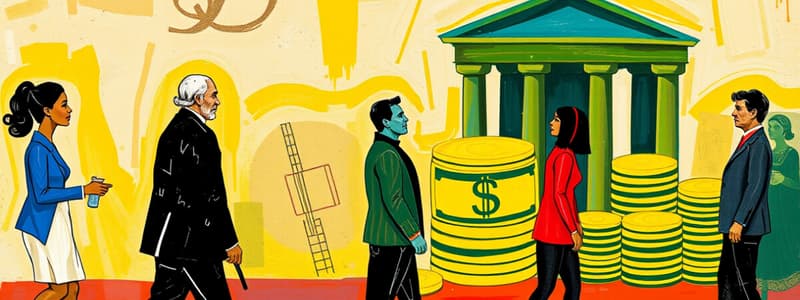Podcast
Questions and Answers
What is the common perception of Canada in terms of social class?
What is the common perception of Canada in terms of social class?
- A wealthy society
- A classless society
- A middle-class society (correct)
- A poverty-stricken society
What is SOCIAL-ECONOMIC STATUS?
What is SOCIAL-ECONOMIC STATUS?
A composite measure of social position that considers also power, occupational prestige, and schooling.
What was the average family income in Canada in 2011?
What was the average family income in Canada in 2011?
$75,900
Which percentage of all income did the top 20% earn in 2011?
Which percentage of all income did the top 20% earn in 2011?
What is included in wealth?
What is included in wealth?
White-collar workers generally have less occupational prestige than blue-collar workers.
White-collar workers generally have less occupational prestige than blue-collar workers.
Which group tends to accumulate less wealth and earn less income?
Which group tends to accumulate less wealth and earn less income?
What are the four general social classes in Canada?
What are the four general social classes in Canada?
What defines Upper-uppers in Canadian society?
What defines Upper-uppers in Canadian society?
What percentage of the Canadian population are Lower-uppers?
What percentage of the Canadian population are Lower-uppers?
What is the demographic proportion of the Middle Class in Canada?
What is the demographic proportion of the Middle Class in Canada?
Define the working class in Canada.
Define the working class in Canada.
Flashcards are hidden until you start studying
Study Notes
Social Class in Canada
- Canada is often perceived as a middle-class society, but socio-economic stratification is significant.
- Many poor families face daily struggles to meet basic needs, while wealthy families control the majority of financial resources.
Dimensions of Social Inequality
- Social class is multi-dimensional; inequality is not only determined by financial assets but also by power, occupational prestige, and education.
- Socio-economic status is the aggregate measure of an individual’s social standing based on various factors.
Income in Canada
- Income encompasses wages, salaries, investment earnings, and government payments.
- In 2011, the average family income was $75,900, with dual-income families earning significantly more.
- The wealthiest 20% earned 44.3% of total income, whereas the poorest 20% earned only 4.8%.
Wealth Distribution
- Wealth extends beyond income; it includes total assets minus debts, and its distribution is even less equitable.
- In the U.S., the richest 20% hold 89% of total wealth, illustrating extreme wealth concentration.
Power and Occupational Prestige
- Wealth is a key source of power, influencing occupational status, income, and social authority.
- Occupations such as physicians and lawyers are esteemed, while low-wage jobs like cashiers are viewed with less prestige.
- White-collar roles generally have higher social esteem than blue-collar ones.
Role of Education
- Education is crucial for workforce participation and income levels; it is a highly valued societal asset.
- Gender disparities in education are minimal in similar job roles, but women have an overall higher level of educational attainment.
- A strong correlation exists between educational achievement and earnings potential.
Influence of Ancestry
- Ancestry significantly impacts one’s initiation into social inequality, affecting life opportunities.
Canadian Stratification: Merit vs. Caste
- Some families maintain wealth and influence across generations.
- Being born into wealth or poverty plays a critical role in shaping future educational and occupational trajectories.
Race and Ethnicity Impact
- Social position is notably influenced by race and ethnicity, with certain groups achieving higher average incomes.
- Japanese, British, and French individuals generally have higher incomes compared to Chinese, Black, and Indigenous populations, with Quebecois and First Nations experiencing the lowest earnings.
Gender Disparities
- Women consistently earn less than men, with lower wealth accumulation and occupational prestige.
- Single-parent families led by women are more than twice as likely to face poverty compared to those headed by men.
Social Class Structure in Canada
- Sociological definitions of social classes vary, making it complex to delineate this hierarchy due to low status consistency.
- General social classes include the Upper class, Middle class, Working class, and Lower class.
Upper-Uppers
- Represent less than 1% of Canadians, these families possess significant inherited wealth, often referred to as "blue bloods."
Lower-Uppers
- Comprising 2-4% of the population, these are the "working rich" who, despite wealth accumulation, are often excluded from elite societal circles.
The Middle Class
- Represents 40-50% of Canadians, exerting considerable cultural influence as portrayed in media and advertising.
- More ethnically diverse than the upper class, reflecting a wider range of experiences and backgrounds.
Upper-Middles
- This group includes highly educated professionals who accumulate substantial property.
Average-Middles
- Composed of managers and skilled workers, this class tends to have children attending local universities, accumulating some wealth over time.
The Working Class
- About one-third of the Canadian population, sometimes referred to as the lower-middle class, characterized by blue-collar jobs which often lack creativity and face high supervision.
Studying That Suits You
Use AI to generate personalized quizzes and flashcards to suit your learning preferences.




